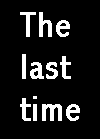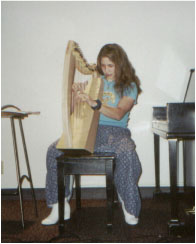








Here I am before going off to an SCA dance party. This is one of our new harps, a semi-grand Venus Penti
| Long live the Irish!!! Cead Mile Failte! That's Gaeilge for 'A Hundred Thousand Welcomes!'
Thank ye fer visitin' my site. I hope ye like it. Is mise Áine nic Ehbhe, agus is Éireannach mé. I'm Irish, both in blood and heart. I am descended from the Barrie clan. I'm also related to the author of Peter Pan! |
Updated 03/29/03
I spent 3 weeks in Ireland in Jan '01, and here are some photos. Bhí sé go hiontach! It was grand, grand!!

Click to subscribe to Ceilí, Ceol n Craic,
my online Celtic music group!
I play a lot of instruments, but only a few really well. At home, I have several harps and accordions, as well as dulcimers (both kinds), violins, mandolins, a guitar, recorders, a tinwhistle, harmonicas, bódhrans, and an autoharp. And our musical library? Well, we really should erect another building for it all. Music is our only vice, heheh!
I also play in a Celtic band called Keltic Cross-Fire. The site is still small, but will of course get bigger as we grow in popularity :)
|

|

Home

Links
Amazon
Pyramid Collection
Panpipes
Gaelsong
Dancing Dragon
Irishop
Beo News
Ireland's Eye
Irish Studies
Welsh Linguru
Irish toasts

Fast fact:
You may not have known it, but Lucky Charms is not an Irish cereal!

Proud to be a Celt!


|
|
 Irish Dance Irish Dance
History
It has been around for centuries. The earliest records of dance in Ireland is from the Druids, whose circular dances to the Sun and Oak tree still are retained in dances today.
In the mid-18th century, the dancing masters appeared in Ireland. They traveled from village to village, teaching the children to dance in return for keep or money; some poorer people payed him in the form of chickens. He usually was accompanied by a minstrel, often a blind piper or fiddler, who was paid half what the master was paid.
Dancing masters had districts, or informal jurisdictions, where they stayed, never encroaching on another's territory. If they met at fairs, it was common for them to contend, who could dance the longest. Upon death, masters would leave their district to another master, or to his best pupil.
In old Ireland, houses were small and had two-piece doors and no floor. So people, to have a flat surface to dance on, would take down the top door and put it on the floor! Nice rhyme. They also danced on tables. It was considered a high honor to be able to do this.
Oh, why do they dance with their arms down and look like they're facing a firing squad? Well, I heard that in the factories where a lot of people worked dancing was forbidden, and they worked at tables, assembling things, so their legs didn't show. They had to keep a straight face to not get in trouble by the overseers. Really, though, it was practice. The dancing masters emphasized poise and grace, controlled movements. It was thought that wild arm movement hindered this, and so was discouraged. The body remains perfectly upright and only moves from the hips down. But recently I attended a ceilí dancing lesson and the múinteoir said traditionally dancing was free and easy, relaxed-looking, with the whole body as lively as the legs but that then the style was gradually hummed down and restrained as dancing competitions got stricter in their regulations.
Types: There are 3 basic types of Irish dance--the reel, the jig, and the hornpipe. The reel is usually in 4/4 time and danced by a group. The jig is in 6/8 time and can be group or solo. The hornipe is 9/8, so it sounds like there's an extra note at the end of each measure (because there is).
Costumes
Traditionally, costumes were very simple. In the early times regular wear, which was in most places farm clothing, sufficed. Later on, girls wore a long skirt, a white blouse and black bodice, or a white dress, sash, and green cloak.
Through the variance of history to the present, now costumes are very elaborate, decorated with embroidered designs of knotwork, animals, flowers, and gold trimming. The designs are derived from Irish literature, predominantly the Book of Kells. They consist of a long-sleeve, knee-length dress with a full skirt for girls, and guys usually wore a kilt of their tartan. Yes, Scots aren't the only kilt wearers.
Dancers wear a sort of black ballet slipper with black strings for softshoe dancing and hard leather shoes ("brogues") with hollow heels for hardshoe. Irish hardshoe is the ancestor of American tap, so it's much more difficult and complicated. When the Irish people emigrated in the time of the war and the famine, they spread throughout the world, including Africa, where Irish tap was mixed with the mellow tunes of African flutes and drums to produce softer music and less vigorous dance, which led to American tap!
I have been practising Irish and Scottish dance for 4 years now, learning from instructional videos, since there are no schools within a few hours' travel, unfortunately. I absolutely LOVE it and want to find a really good school where I can get some real teaching and feedback. :) I tried putting together a show about a year ago, but there wasn't enough interest. :(
Recently, I was interviewed by a girl doing a video project on ethnic dances. The crew got me dancing, interviewed and took shots of my room, which was all fun. I was glad for the interest.
Colin Dunne, Michael Flatley, Jean Butler, and Eileen Ivers are my Irish heros.
|



![]()




















 Irish Dance
Irish Dance


